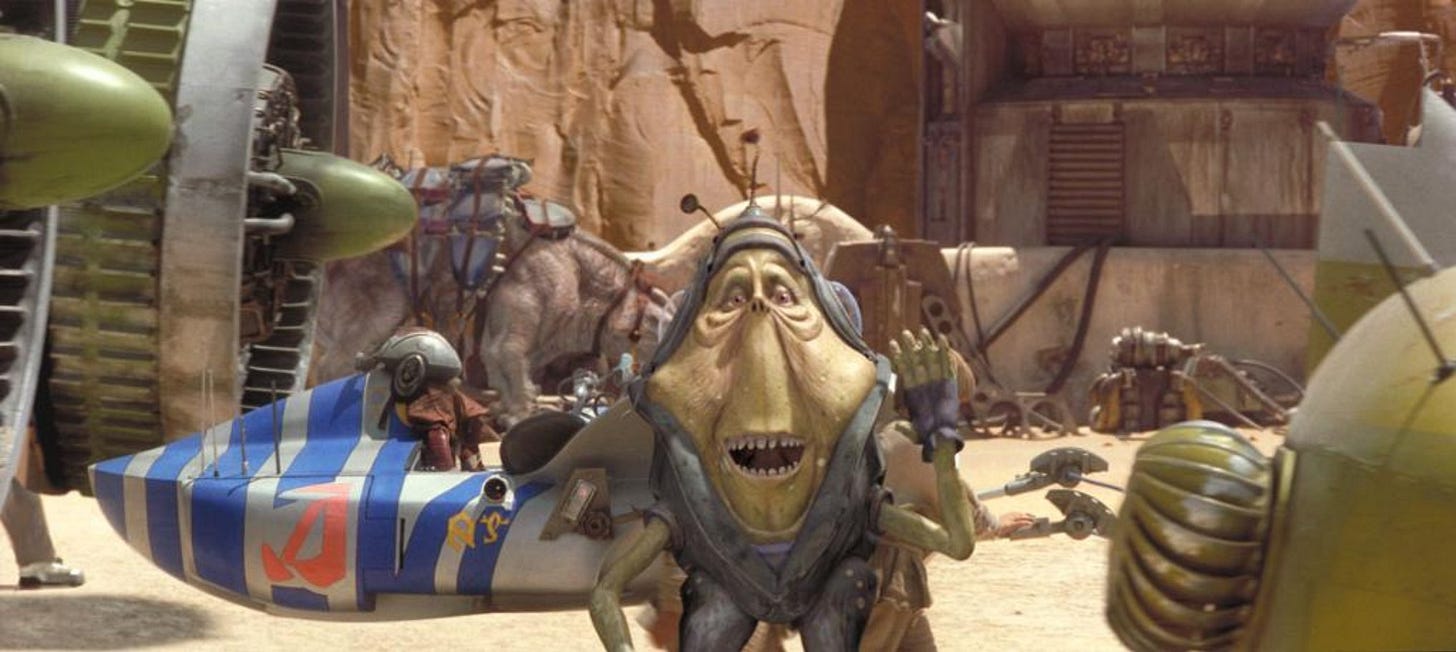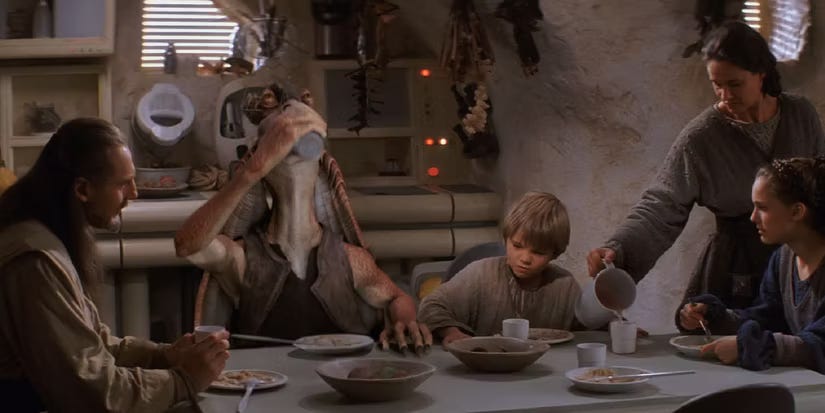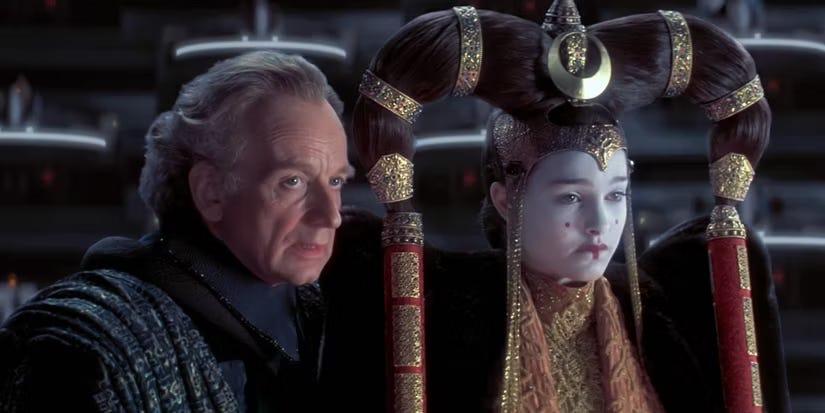Doodling Jar-Jar Binks
A theory of why exactly the Star Wars prequels are as bad as they are, and a reflection on this blog's failure mode
The other night my wife told me that she wanted to watch the Star Wars prequels, and so we sat down and watched the first one, The Phantom Menace.
I think Rachel wanted to watch the prequels because she has a desire (very good in itself!) to have heterodox and interesting opinions. She knows all about the phenomenon of purists not liking an adaptation of a piece of media because ‘it’s not like the originals!’, and my suspicion is that she wondered whether the backlash to the prequels was just down to the fact that they weren’t like the originals. And in turn, given that she is not so much a fan of the original Star Wars movies, she might have thought that someone who didn’t like the originals might actually appreciate the prequels.
But of course, the backlash to the prequels happened because they are just really very bad. And so she didn’t like the movie. Nonetheless, as we watched it, we did have an ok time providing a running commentary on all the ways that The Phantom Menace is a bad film.
See, that the Star Wars prequels are bad is common knowledge; but why they are bad, what had to happen for these films to fail, is a more debatable question. And a big part of the difficulty of explaining this badness is that the prequels fail on so many levels; it’s hard to have a theory of ‘what went wrong’ that can explain all the diverse problems. With apologies for treading back over very old ground, here’s just a few of the many different ways that The Phantom Menace fails:
The actors—many of them accomplished, serious names—were clearly either over-directed or given no direction at all: they lurch about every scene failing to give even an ounce of characterisation, to the point that the over-earnest and annoying child actor was Rachel’s favourite performance.
The plot makes no sense. The protagonists pretty much choose what to do by just following whatever
Liam NeesonQui-Gon Jinn has decided, and he chooses what to do based on … who knows? His plans are inconsistent and turn on a dime, and we have zero insight into his deliberation thanks to the aforementioned characterisation. I mentioned to Rachel the idea (courtesy of Red Letter Media)1 to watch the movie as if Qui-Gon is drunk, taking a sip every time the camera points away from him. Meanwhile, all decisions are made against the backdrop of the overall conspiracy orchestrated by Senator Palpatine, which also makes no sense: Palpatine constantly acts like certain things (e.g., the signing of a particular treaty) are absolutely imperative, and then by the end of the movie you see they’d only have hurt him. And all of this takes place against the backdrop of a trade dispute, a political conflict we are never given any insight into the politics of.Tonally, it’s all over the place. There is one particular scene of The Phantom Menace where our protagonists learn of the horror of slavery on the planet Tatooine: every slave has a bomb implanted inside their body, programmed to explode if they try to run away. This terrifying bleakness is rather undercut by the comedy children’s character who is given a reaction shot after every single line of exposition.
The whole film is like this. (Attack of the Clones is even worse, interrupting a romance plotline with a sequence where one of the two romantic leads commits a Srebrenica-style massacre. I wish I were making that up.)
It’s an incredibly visually ugly film. The CGI is awful, really gummy with fuzzy edges and weird colours, yet the filmmakers went all in on CGI—almost every frame has some CGI in it, and indeed often too much CGI, creating incredibly busy shots. The visual identity of the non-CG elements is no better, alternating between blandly washed-out or blandly bright. The costuming especially looks like it was just thrown together randomly, and is liable to destroy any identity or character that might have slipped through the cracks of the bad acting.2
Any convincing theory of what went wrong with the Star Wars prequels must account for their omnishambolic quality: how did so many things go wrong all at once, when so much money and talent and (presumably) quality control went into these movies?
The visuals were the negative aspect that Rachel highlighted most when we were watching The Phantom Menace. Not because they were particularly interesting to her—it was just that the film just looked so bad, so consistently, that she couldn’t avoid it mentioning it. The CGI drew her particular ire. During the ‘podracing’ sequence, she noted that the various CG aliens aren’t even coherently bad. They all have different visual styles, and so they jar with each other just as much as they jar with the surrounding non-CG elements (and with the audience’s sense of good taste).


When Rachel said this about the podracing aliens, I offhandedly commented: ‘yeah, they all just look like doodles George Lucas did at some point’.
And then it hit me that, actually, this is a pretty good explanation of all of The Phantom Menace’s problems.
See, after the unexpected success of the original Star Wars film, George Lucas spent about a decade and a half doing very little directly creative work except for a few cowritten scripts; he mostly pivoted to being a producer.3 No doubt he’s a creative man, and had various ideas popped into his head over the years: little drawings of alien characters, scenes he wanted to shoot, ideas for the backstories of various Star Wars characters, and so on. But without a project to give coherence to them, these ideas remained (as it were) sketches rather than finished paintings. Sketches—or, indeed, doodles, low-quality in themselves and clashing aesthetically with each other.
And then, when Lucas was given complete creative control over an entire trilogy of films, he populated it with the doodles that he had grown attached to.
I don’t mean to suggest that all the character designs in The Phantom Menace were literally based on napkin doodles Lucas did in the late 1980s—although I’d bet a few were. But all of the characters, and indeed all of the locations and scenes and sequences, are insubstantial, a series of first drafts.4 Lucas tries to make up for this by piling more and more stuff into the movie: more locations, more characters, more visual effects. But without revising any of this stuff in light of everything around it, you just end up with elements that are tonally, visually, and aesthetically inconsistent.
A series of scenes sketched independently of each other will, if the writer doesn’t rethink them in comparison with each other, produce characters whose motivations aren’t consistent from scene to scene, and so cannot be acted consistently (or indeed, acted at all). And it will produce a plot where protagonists just move from one scene to the next with no rhyme or reason to the transition. (Lucas gave Liam Neeson the unenviable job of uttering one line at the end of every scene to ensure the transition is less than completely unfollowable, but a coherent plot or coherent characterisation this does not make.)
The problem wasn’t merely that Lucas was given too much freedom and control and was surrounded by yes men (the most common explanation for ‘what went wrong with the prequels’), although this was obviously part of it. After all, many directors—including many directors of popcorn-munching blockbusters—are able to use their artistic freedom very effectively. It’s more specifically that Lucas used his artistic freedom to create a series of doodles, piling sketches on top of each other rather than developing a few of them into a finished painting. The resultant incoherence is what produces all of the film’s major problems.
So that’s my theory of what went wrong with The Phantom Menace.5 I was quite pleased with having come up with it. Then it made me rather worried.
Last week I went to a meetup of Glasgow Substack writers, hosted by
and . It was great fun to meet so many interesting people, and it was an absolute treat to have such cool conversations. But I did face one problem, in having to deal with every single person’s conversation opener: ‘What is your Substack about?’Others who were asked this question had great, succinct summaries—‘critical theory’, ‘science writing’, ‘local news’. But I had nothing. I hadn’t even prepared some self-deprecating answer (rookie error, I know); I just stumbled, with long gaps and lots of umming and ahhing, before my conversation partners felt sorry for me and stepped in to fill the gap.
Because, like, what am I writing about here? There’s very little thematic or topical coherence between anything I write: my choice of topics has mostly followed whatever I happen to be reading about that week outside of work—or else, requests from my mum. What I’m offering here is a series of sketches, or—and this is the risk—a series of doodles.
This is similar to the age-old question of generalists versus specialists, hedgehogs versus foxes, which Neil has written about before.6 But I think that the problem I’m worried about is slightly different. Neil brushes up against the fact that successful generalists don’t actually tend to have totally disconnected bodies of work: their output is not united by genre or form, but it is united by the personality of the writer, their ‘unique voice and … particular perspective’ applied to different topics. George Lucas’ problem was not that he was a generalist. (He’s not even really a generalist.) His problem was that the creative outputs he fed into the Star Wars prequels had no particular artistic perspective and reflected no unified creative personality. They were mere doodles.
Now, there’s nothing wrong with doodles qua doodles. They’re meant to be fun little distractions, and there’s typically no reason to judge them according to any other criteria. When we see the doodles of an artist or historical figure, they can even add a little ‘colour’ to our vision of them.
But The Phantom Menace doesn’t even work as a distraction, and it shows that there is a more serious failure mode. Idle doodles that are merely uninteresting when taken individually, can clash and actually be aesthetically offensive when shoved together and piled on top of one another. One podracing alien is a cute little doodle; a dozen of them is an ugly and incoherent scene. It’s all about context and space.
I’ve got complete artistic freedom over this Substack; I’m limited only by my desires and the obligations of my day job. The temptation is to use this as an excuse to simply intellectually ‘doodle’, writing freely and idly about whatever strikes my fancy without exercising restraint or attempting to impose tonal consistency. And this is pretty much how I’ve been proceeding thus far, writing about Yeats and then Taylor Swift and then the religious thought of the American Civil War and then my intuitions for duality in differential geometry.
My justification has been that I’m just doing this for fun, and I have no desire to ever make this into anything more than a hobby. But the lesson of The Phantom Menace is that, without a distinct authorial personality to impose coherence and unity, bringing together a bunch of fun little sketches can produce something that is so much less than the sum of its parts; my fun little blog becomes not merely meaningless but actively irritating to people who subscribe based on one thing and then get hit with a thousand other topics.
I’m not sure what the best way to proceed is. I am actually interested in all these topics, and have found writing about them intellectually stimulating. But while I will continue along my path for the time being, I will try to keep the lessons of The Phantom Menace in mind.
It might be worthwhile to give a content warning for this link—the humour is quite black and indeed intentionally ‘edgy’, in a way that may or may not land with you. I’ve not watched it in a while so I can’t really give specifics.
A notable exception is the lightsabre fight at the climax of the film, where Liam Neeson Qui-Gon Jinn dies, which is actually set in quite a visually interesting space and with interesting effects. The choreography and pacing still conspire to ensure it’s shit; but it is by far the least shit sequence in The Phantom Menace.
Notably, he didn’t even direct the two immediate sequels to Star Wars.
Wikipedia tells me that when the character of General Grievous was being designed for the third prequel film, Revenge of the Sith, ‘[t]he only instruction Lucas gave his art department was to make the character “iconic” and “scary”.’
It applies to the other Star Wars prequel films too, mutatis mutandis.
Neil himself has transitioned his Substack from generalist and topic-neutral to a specialist blog about photography.






Don’t worry, your brain is sufficiently sharp such that what might count as a doodle for you is better than many people’s finished paintings.
Also, I suspect you’re like me: writing feels essential to maintain minimally acceptable cognitive standards. It’s exercise for the brain. So do your exercise as feels right; give no more of a crap whether others like your very good doodles then you would care whether they did not like a route you chose to jog on.
(the worst thing about spending eight months in hospital was how being unable to write, or even read, I could feel myself becoming stupider. Luckily, that part was reversible. Shame about my stupid spinal cord.)
A blog doesn't have to be a painting, it's perfectly fine for it to be an art gallery. Or, to switch metaphors — once you've figured out that being Kant is off the table, you can do a lot worse than being Lichtenberg.